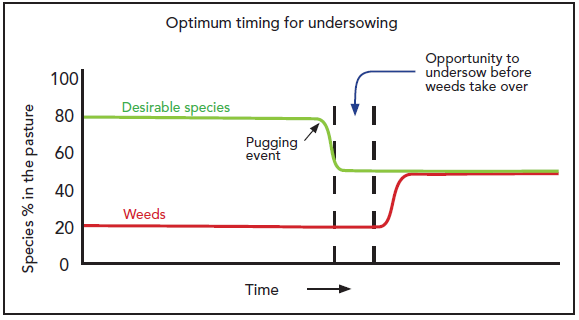Managing pasture in wet conditions
Pugging and treading damage can reduce pasture DM production by ≥ 35%. Severe pugging by cattle can kill pastures (see photo below). Where pastures are badly damaged, repairing them is a race against time. New seed needs to be sown before weeds take over.

How to minimise pugging damage
There are several strategies available:
- Draw up a wet weather management plan and make sure everyone shifting stock on the farm understands the plan.
- Paddocks known to be vulnerable to wet conditions (including new grass) should be grazed early, i.e. autumn, in case the weather turns wet later on.
- On:off graze - remove stock from pasture after 2-4 hours grazing onto a stand off pad or sacrifice paddock (e.g. one going into crop). Sacrificing one paddock is better than damaging many.
- Spread stock out at low stocking rates.
- Don’t worry about post-grazing residuals when it’s wet. Concentrate on protecting your soils. Focus back on residuals when conditions are dry again.
- Create laneways within paddocks which are being break-fed, to limit treading damage to smaller areas.
- Avoid grazing tetraploid pastures during heavy rain. Diploid pastures are denser and more likely to persist through a pugging event.
- Keep machinery off wet paddocks - feed out a couple of days in advance.
There are several strategies available:
Even with a good plan, the need to feed stock in wet weather means pasture damage can happen.
- Restoring pastures after bad pugging damage is a race against time. If you don't get productive species back into the bare ground, fast growing weeds will quickly fill the gaps.
- If used at the right time (see graph below), undersowing is a useful tool for repairing damage.

- In early spring, sow as soon as soil temperatures are above 6oC for annual or Italian ryegrass, or 8°C for perennial ryegrass. Sow seed at 10–15 kg/ha for thin pasture and 15-20 kg/ha for severe damage.
- For larger areas, mark damaged area(s) on a farm map, and give the map to the contractor to undersow (provided damaged areas are level enough, otherwise surface cultivate first).
- Consider undersowing with an Italian ryegrass (e.g. Tabu+). This will give quick DM growth, and is ideal where the plan is to fully renovate the paddock within the next 6-12 months. Shogun hybrid ryegrass will provide 2-3 years' production; Forge will give 3-5 years. Where there are no plans to renew the pasture, undersow with perennial ryegrass.
- Where pugging is severe, consider full renovation, either through a summer crop or in irrigated areas via grass to grass in spring.
- For smaller bare gaps, e.g. gateways, grass seed can be oversown or broadcast. A higher sowing rate will be required, e.g. 30 kg/ha, because establishment is poorer than drilling.

